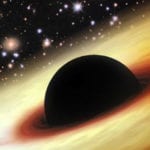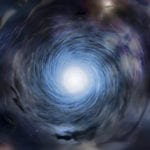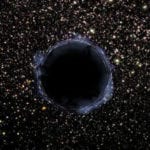 Music
Music  Music
Music  History
History 10 Less Than Jolly Events That Occurred on December 25
 Weird Stuff
Weird Stuff 10 Funny Ways That Researchers Overthink Christmas
 Politics
Politics 10 Political Scandals That Sent Crowds Into the Streets
 Weird Stuff
Weird Stuff Ten Bizarre Facts About The Doge Meme
 Our World
Our World 10 Ways Your Christmas Tree Is More Lit Than You Think
 Movies and TV
Movies and TV The 10 Coolest Stars to Set Sail on The Love Boat
 History
History 10 Things You Didn’t Know About the American National Anthem
 Technology
Technology Top 10 Everyday Tech Buzzwords That Hide a Darker Past
 Humans
Humans 10 Everyday Human Behaviors That Are Actually Survival Instincts
 Music
Music 10 Surprising Origin Stories of Your Favorite Holiday Songs
 History
History 10 Less Than Jolly Events That Occurred on December 25
 Weird Stuff
Weird Stuff 10 Funny Ways That Researchers Overthink Christmas
Who's Behind Listverse?

Jamie Frater
Head Editor
Jamie founded Listverse due to an insatiable desire to share fascinating, obscure, and bizarre facts. He has been a guest speaker on numerous national radio and television stations and is a five time published author.
More About Us Politics
Politics 10 Political Scandals That Sent Crowds Into the Streets
 Weird Stuff
Weird Stuff Ten Bizarre Facts About The Doge Meme
 Our World
Our World 10 Ways Your Christmas Tree Is More Lit Than You Think
 Movies and TV
Movies and TV The 10 Coolest Stars to Set Sail on The Love Boat
 History
History 10 Things You Didn’t Know About the American National Anthem
 Technology
Technology Top 10 Everyday Tech Buzzwords That Hide a Darker Past
 Humans
Humans 10 Everyday Human Behaviors That Are Actually Survival Instincts
10 Of The Biggest Things In The Universe
With technology rapidly advancing, astronomers are finding more and more objects in the universe. The title of “largest thing in the universe” is changing almost yearly. Some of these cosmic objects are so large that they baffle our best scientists, and some of them shouldn’t even exist at all.
10The Supervoid
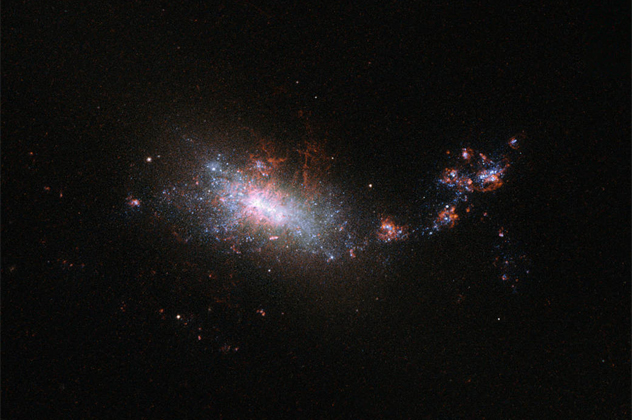
Recently, astronomers have discovered the largest void in the known universe. It lies in the southern constellation of Eridanus. Spanning 1.8 billion light-years, it’s baffling scientists, who never imagined such a thing could exist.
Despite the name “void,” a void in space is not completely empty. It is an area of space that is under-dense, in this case having 30 percent fewer galaxies than the surrounding area. Voids make up 50 percent of the universe, a number that’s only expected to grow as gravity pulls all surrounding matter toward itself. Two things stand out about this void: its immense size and its relation to the mysterious WMAP Cold Spot.
This new supervoid is now the most widely accepted explanation for the cold spot, a large, seemingly empty region in the cosmic radiation background. There have been a range of controversial theories to explain the cold spot, from our universe orbiting a universe-sized black hole to a parallel universe pushing against our own. These days, most scientists believe that the cold spot might be caused by the supervoid: As protons pass through the void, they lose energy and weaken. Still, there is a slight possibility that the supervoid’s location in relation to the cold spot could be coincidental. Scientists need to find out more to prove whether or not the void is causing the mysterious cold spot or if it’s something else entirely.
9The Newfound Blob
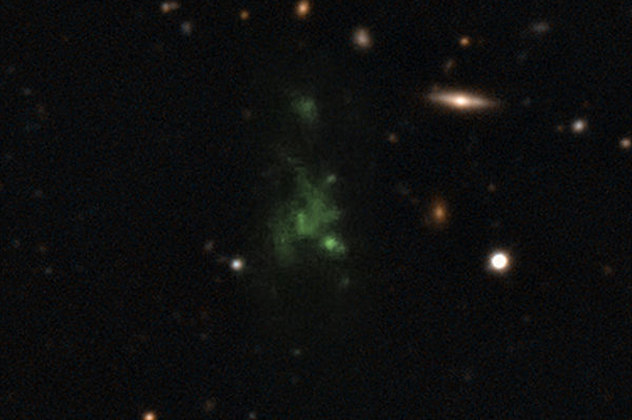
In 2006, a mysterious blob was named the largest structure in the universe, although it quickly lost its title to newer discoveries. This blob is a giant mass of gas, dust, and galaxies that is 200 million light-years wide and looks like a cluster of green jellyfish. It was found by Japanese astronomers who had been studying a region of the universe known to have large concentrations of gas. To do this, they placed a special filter on their telescope, which coincidentally allowed them to pick up the presence of the blob.
Each of its three “arms” has galaxies packed four times denser than the universe’s average. The galaxies and the gas bubbles contained within the blob are called Lyman-alpha blobs. These are believed to have formed a mere two billion years after the big bang, just a blink of an eye in the cosmic timeline. Scientists think they formed when massive stars from the universe’s earliest days went supernova and blew out their surrounding gases. Because this structure is so large, the astronomers believe it is one of the very first to have formed. They theorize that in the distant future, even more galaxies will emerge from the gases contained in the blob.
8The Shapley Supercluster
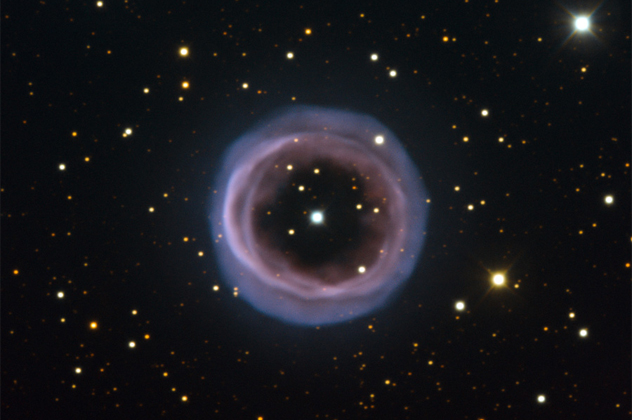
For years, astronomers have known that the Milky Way galaxy was being pulled through the universe at a speed of 2.2 million kilometers per hour toward the constellation Centaurus. Astronomers theorized that this was happening due to a Great Attractor, an object with a gravitational pull strong enough to draw our galaxy toward it. They couldn’t know for certain, though, because it lay behind the Zone of Avoidance (ZOA), the part of the universe obscured by the Milky Way.
But while conventional astronomy can’t penetrate the ZOA, X-ray astronomy eventually became advanced enough to peer through the haze and locate the Great Attractor, which was revealed to be a large cluster of galaxies. However, there remained a problem. The Attractor they found couldn’t create a pull as strong as what astronomers were detecting. It only accounted for 44 percent of the observed pull. Focusing their telescopes out even further, they soon found that our galaxy’s cosmic tow truck was itself being pulled toward something even larger: the Shapely Supercluster.
The Shapley Supercluster is a large collection of galaxies behind the Great Attractor that is pulling both the Attractor and our own galaxy toward it. It is a cluster of more than 8,000 galaxies with a mass of more than 10 million Suns. Every galaxy in our region of the universe is on a collision course with it.
7The Great Wall
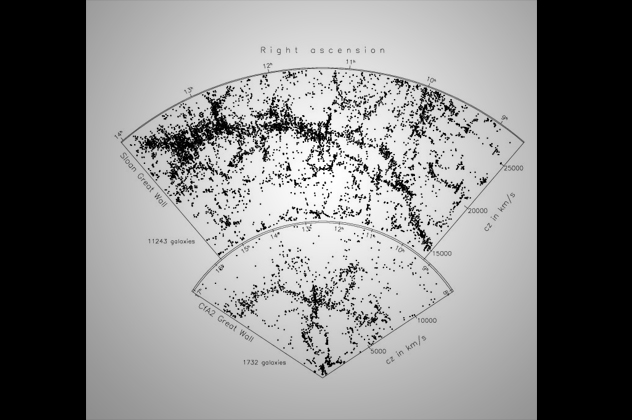
Like many of the structures on this list, the Great Wall, or CfA2 Great Wall, once held the distinction of being the largest known object in the universe. It was discovered by American astrophysicists Margaret Joan Geller and John Peter Huchra during a redshift survey for the Harvard-Smithsonian Center for Astrophysics, hence the name CfA. The structure is estimated to be 500 million light-years in length and 16 million in depth, and it’s shaped somewhat like the Great Wall of China.
The exact measurements of the Great Wall, however, remain a mystery. It could be much larger, stretching out to a possible 750 million light-years. The problem with determining its true size lies in its location. Like the Shapely Supercluster, the Great Wall is partially obscured by the Zone of Avoidance. The ZOA makes 20 percent of the observable universe extremely difficult to detect because dust and dense gas in the Milky Way—as well as the high concentration of stars—heavily obscure optical wavelengths.
To see through the ZOA, astronomers have to observe the universe through wavelengths not affected by the dust, such as infrared surveys, which penetrate an additional 10 percent of the ZOA. Radio surveys can also uncover what infrared cannot, as can near-infrared and X-rays, but it is frustrating for astronomers to not be able to actually see such a large portion of the universe. The ZOA leaves a number of gaps in our knowledge of the cosmos.
6The Laniakea Supercluster
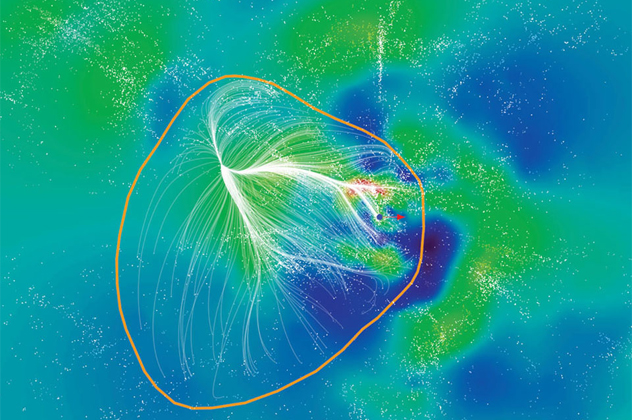
Galaxies tend to group together in clusters. Regions where clusters are more densely packed than the universal average are called superclusters. Previously, astronomers mapped these objects by their physical locations in the universe, but a recent study has found a new way of mapping the local universe, one that is shedding light on its unknown corners.
The new study maps the local universe and its galaxy clusters based on gravitational pull instead of position. This new method charts the positions of galaxies to infer the gravitational landscape of the universe. It’s considered superior to the old system because it allows astronomers to map the uncharted regions of the universe as well as what we can observe. Since it relies on detecting a galaxy’s influence instead of the galaxy itself, it can detect objects even if we can’t see them.
The study’s findings, which only apply to our local galaxies, are recharting the local universe. The research team now defines a supercluster based on the boundaries of its gravitational flow. It is especially meaningful for us, since it has redefined where we sit in the universe. The Milky Way was once thought to be inside the Virgo supercluster, but under the new definition, our region is only an arm of the much larger Laniakea supercluster, one of the largest objects in the universe. Stretching 520 million light-years across, it is the Earth’s new address in the universe.
5The Sloan Great Wall
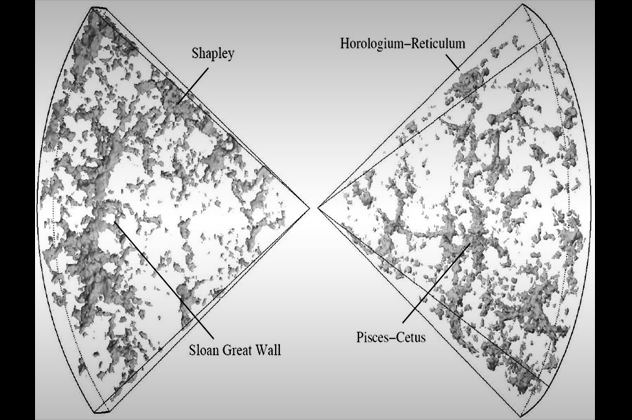
The Sloan Great Wall was first discovered in 2003 by the Sloan Digital Sky Survey, a survey mapping hundreds of millions of galaxies in order to reveal the large-scale structure of the universe. The Sloan Great Wall is an enormous galactic “filament” that contains several superclusters that weave through the universe like the tentacles of an enormous octopus. At 1.4 billion light-years across, it once held the title of largest structure in the universe.
The Sloan Great Wall itself has not been studied as much as the superclusters within it, several of which have proven quite interesting in their own right. One has a rich core of galaxies trailing away from it like tendrils. Another has a high rate of interaction between galaxies within it, including some that are still actively merging.
The Wall, and any structure larger, have given rise to a new mystery about the universe. It surpasses the cosmological principle, which puts a theoretical limit on how large universal structures can be. The principle posits that the universe has a uniform distribution over large scales, and nothing larger than 1.2 billion light-years can exist. Structures the size of Sloan Great Wall completely contradict that.
4The Huge-LQG
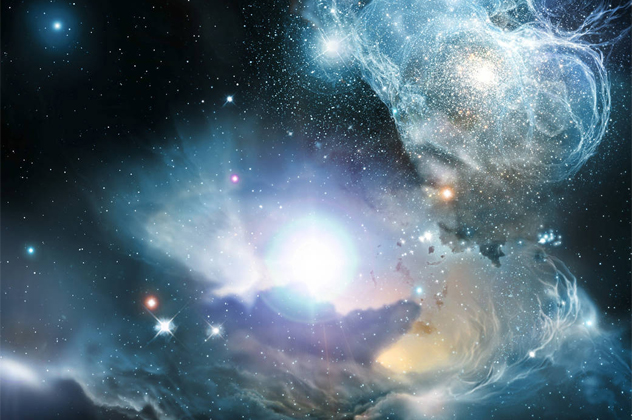
A quasar is an extremely energetic region at the center of a galaxy. Powered by supermassive black holes, quasars have an energy output 1,000 times greater than anything found in the entire Milky Way. The current third-largest structure in the universe is the Huge-LQG, a cluster of 73 quasars spreading out over 4 billion light-years. This large quasar group (LQG) and others like it have been proposed as the precursors for many of the larger-scale structures in the universe, such as Sloan’s Great Wall.
The Huge-LQG was discovered after analyzing data from the same survey that located Sloan’s Great Wall. Researchers posited its existence after mapping the area with a “friends-of-friends” algorithm that mapped the density of quasars within a certain amount of space. The method, though, is not without its skeptics, and the existence of this particular structure is a matter of debate.
While some astronomers claim that the Huge-LQG is real, others posit that the quasars are randomly placed and not part of any large structure. Another researcher took a look at the Huge-LQG and found it to be nothing more than randomly spaced objects. Whether it exists or not is still up for debate, although evidence is leaning toward the Huge-LQG being a legitimate discovery.
3The Giant GRB Ring
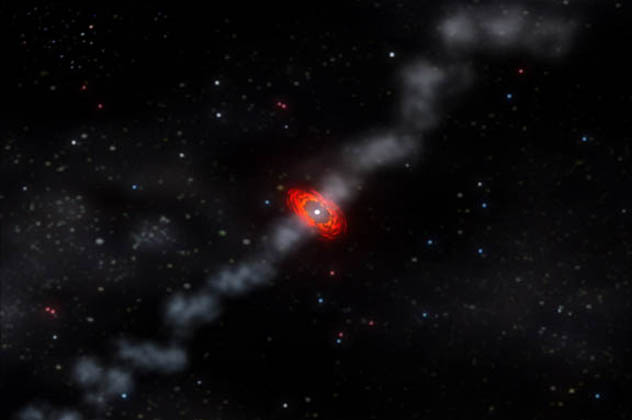
At a whopping 5 billion light-years across, the second-largest structure in the universe is the Giant GRB Ring. Aside from its enormous size, what’s odd about the structure is its peculiar shape. Astronomers studying gamma ray bursts (large bursts of energy created when a massive star reaches the end of its life) picked up a series of nine bursts, all a similar distance from Earth, that formed a ring in the sky more than 70 times the diameter of the full Moon. Given that gamma ray bursts (GRBs) are a very rare phenomenon, the chance for such a shape to form randomly is 1 in 20,000, making researchers speculate that they had stumbled upon the then-largest structure in the universe.
The “ring,” though, is only a visual impression as seen from Earth. It’s theorized that the Giant GRB Ring could be a projection of a sphere where the GRBs all happened within a relatively short period of 250 million years. It poses the question as to what could possibly have created a sphere that big. One explanation revolves around the possibility that the galaxies could be clumped around enormous concentrations of dark matter, but so far, that’s only a theory. Researchers really have no idea how structures like these formed.
2The Hercules-Corona Borealis Great Wall
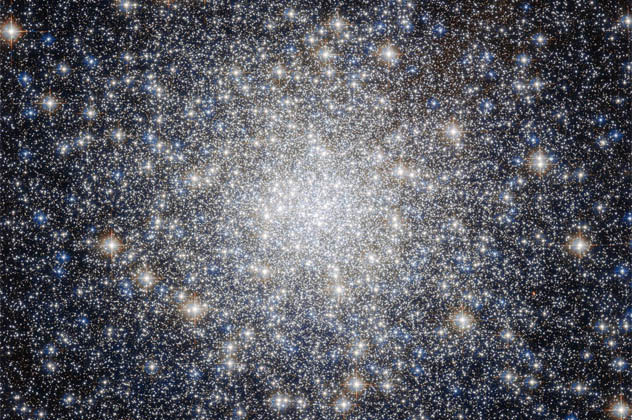
The current largest structure in the universe was also discovered by astronomers scanning for gamma ray bursts. This structure, named the Hercules-Corona Borealis Wall, is 10 billion light-years across, making it twice the size of the Giant GRB Ring. Because the bigger stars that emit GRBs are typically formed in areas with more material, astronomers treat each burst as a pin sticking to something bigger. When scientists found a region of space in the direction of the constellations Hercules and Corona Borealis that had a large number of GRBs, they determined that the structure was probably a dense concentration of galaxy clusters and other matter.
The name Hercules-Corona Borealis Great Wall itself was coined by a teenage Wikipedia author in the Philippines. After a Discovery News article mentioned what part of the sky the structure had been found in, a Wikipedia page popped up christening it with its new name. Although the name is not actually correct since the structure is so large it occupies several more constellations, the Internet was quick to pick up on it. It was perhaps the first time Wikipedia named a scientific structure. Since the Wall is well over the cosmological principle, it and other structures like it are challenging scientists to rethink their idea of how the universe formed in order to accommodate their existence.
1The Cosmic Web
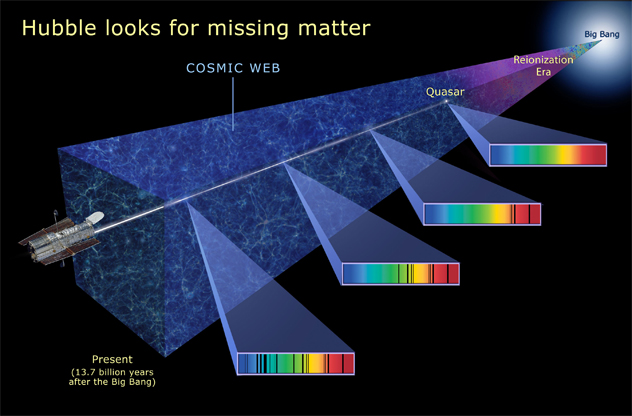
Scientists believe that the distribution of the universe is not random. It’s been theorized that galaxies are organized in an enormous universal structure with thread-like filaments connecting dense regions. These are interspersed between less dense voids. They call it the Cosmic Web.
The Web is believed to have formed very early in the history of the universe. It began with small fluctuations in its earliest formation, which later helped shape all existence. The filaments in particular are believed to have played a large role in the universe’s evolution, which is accelerated within them. Galaxies inside the filaments have a much higher rate of creating stars. They are also more likely to experience gravitational interaction with other galaxies. It’s a process that is likely continuing even now. Inside the filaments, galaxies are sort of pre-processed and funneled toward galaxy clusters, where they then go to die.
Only recently have scientists begun to understand the Cosmic Web. They have even captured it in pictures with radiation from a distant quasar. Quasars are the brightest objects in the universe, and light from one happened to be pointing toward a filament, which made its gases glow. With it, astronomers captured an image of the threads stretching between galaxies, a picture of the skeleton of the cosmos.
Nathan keeps a Japan blog where he writes about the sights, expat life, and finds Japanese culture in everyday items. You can also find him on Facebook and Twitter.
